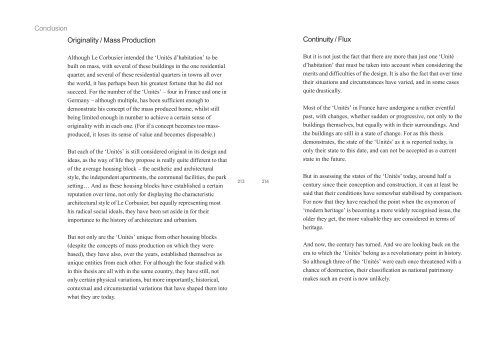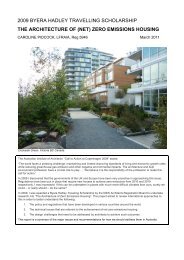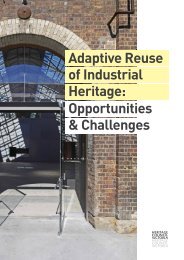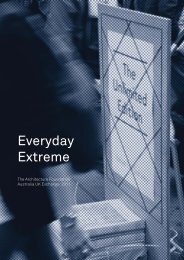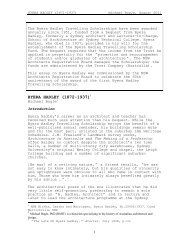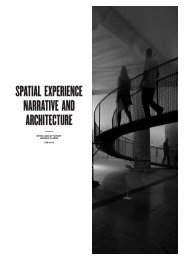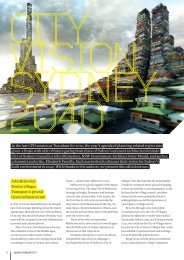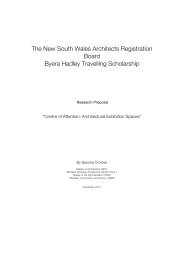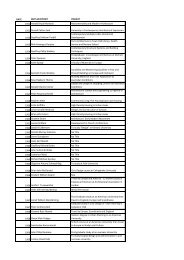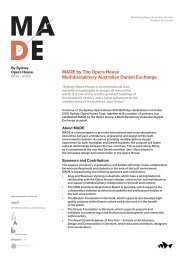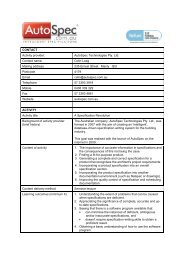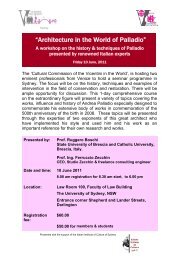4 unités LC - Architecture Insights
4 unités LC - Architecture Insights
4 unités LC - Architecture Insights
Create successful ePaper yourself
Turn your PDF publications into a flip-book with our unique Google optimized e-Paper software.
Conclusion<br />
Originality / Mass Production<br />
Although Le Corbusier intended the ‘Unités d’habitation’ to be<br />
built on mass, with several of these buildings in the one residential<br />
quarter, and several of these residential quarters in towns all over<br />
the world, it has perhaps been his greatest fortune that he did not<br />
succeed. For the number of the ‘Unités’ – four in France and one in<br />
Germany – although multiple, has been sufficient enough to<br />
demonstrate his concept of the mass produced home, whilst still<br />
being limited enough in number to achieve a certain sense of<br />
originality with in each one. (For if a concept becomes too massproduced,<br />
it loses its sense of value and becomes disposable.)<br />
But each of the ‘Unités’ is still considered original in its design and<br />
ideas, as the way of life they propose is really quite different to that<br />
of the average housing block – the aesthetic and architectural<br />
style, the independent apartments, the communal facilities, the park<br />
setting… And as these housing blocks have established a certain<br />
reputation over time, not only for displaying the characteristic<br />
architectural style of Le Corbusier, but equally representing most<br />
his radical social ideals, they have been set aside in for their<br />
importance to the history of architecture and urbanism.<br />
But not only are the ‘Unités’ unique from other housing blocks<br />
(despite the concepts of mass production on which they were<br />
based), they have also, over the years, established themselves as<br />
unique entities from each other. For although the four studied with<br />
in this thesis are all with in the same country, they have still, not<br />
only certain physical variations, but more importantly, historical,<br />
contextual and circumstantial variations that have shaped them into<br />
what they are today.<br />
213 214<br />
Continuity / Flux<br />
But it is not just the fact that there are more than just one ‘Unité<br />
d’habitation’ that must be taken into account when considering the<br />
merits and difficulties of the design. It is also the fact that over time<br />
their situations and circumstances have varied, and in some cases<br />
quite drastically.<br />
Most of the ‘Unités’ in France have undergone a rather eventful<br />
past, with changes, whether sudden or progressive, not only to the<br />
buildings themselves, but equally with in their surroundings. And<br />
the buildings are still in a state of change. For as this thesis<br />
demonstrates, the state of the ‘Unités’ as it is reported today, is<br />
only their state to this date, and can not be accepted as a current<br />
state in the future.<br />
But in assessing the states of the ‘Unités’ today, around half a<br />
century since their conception and construction, it can at least be<br />
said that their conditions have somewhat stabilised by comparison.<br />
For now that they have reached the point when the oxymoron of<br />
‘modern heritage’ is becoming a more widely recognised issue, the<br />
older they get, the more valuable they are considered in terms of<br />
heritage.<br />
And now, the century has turned. And we are looking back on the<br />
era to which the ‘Unités’ belong as a revolutionary point in history.<br />
So although three of the ‘Unités’ were each once threatened with a<br />
chance of destruction, their classification as national patrimony<br />
makes such an event is now unlikely.


